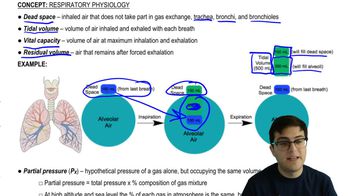40. Circulatory System
Gas Exchange
40. Circulatory System
Gas Exchange
Additional 13 creators.
Learn with other creators
Showing 16 of 16 videos
Practice this topic
- Multiple ChoiceHow does myoglobin aid diving mammals such as the Weddell seal?1448views
- Multiple ChoiceWhich of the following would increase the release of oxygen from red blood cells?1564views
- Multiple ChoiceWhen you hold your breath, which of the following blood gas changes leads initially to the urge to breathe again?1182views
- Multiple ChoiceWhat causes CO2 in the blood to decrease?1160views
- Textbook Question
Complete the following concept map to review some of the concepts of gas exchange.
1558views - Textbook Question
When you hold your breath, which of the following first leads to the urge to breathe?
a. Falling CO2
b. Falling O2
c. Falling pH of the blood
d. Rising pH of the blood
1115views - Textbook Question
Which of the following promotes oxygen release from hemoglobin?
a. A decrease in temperature
b. An increase in O₂ level.
c. A decrease in pH
d. A decrease in carbonic anhydrase activity
1514views - Textbook Question
When you hold your breath, which of the following blood gas changes first leads to the urge to breathe?
a. Rising O2
b. Falling O2
c. Rising CO2
d. Falling CO2
1394views




















